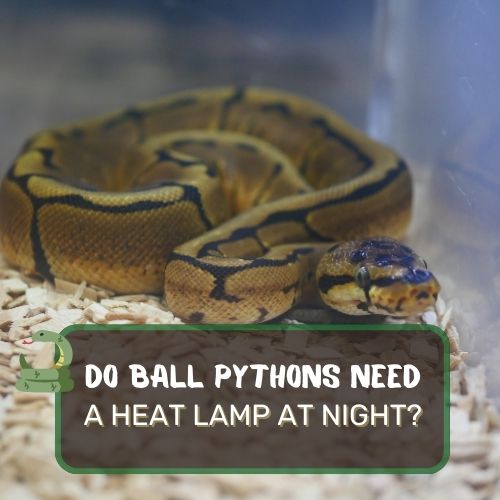
“Do ball pythons need heat at night?” It’s a question that has slithered its way into the minds of many reptile enthusiasts.
Ball Pythons, with their captivating patterns and docile nature, are a favorite among pet owners. But, like any exotic pet, they come with their unique set of needs.
In this article, we’ll delve deep into the world of Ball Python heating, exploring the importance of temperature, the pros and cons of various heating methods, and the nighttime needs of these mesmerizing creatures. B
y examining factors like their natural habitat, metabolism, and behavior, we aim to provide a comprehensive answer to the burning question.
So, whether you’re a seasoned snake owner or just curious, stick around to uncover the heated truths and myths about Ball Python care.
Table of Contents
- 1 Do Ball Pythons Need A Heat Lamp At Night?
- 2 The Importance of Heat for Ball Pythons
- 3 Optimal Temperatures for Ball Pythons
- 4 Heat Lamps vs. Other Heating Methods
- 5 Nighttime Needs: Do Ball Pythons Require Continuous Heat?
- 6 Choosing the Right Heat Lamp
- 7 Potential Risks and How to Avoid Them
- 8 Final Word
- 9 FAQ
Do Ball Pythons Need A Heat Lamp At Night?
Ball Pythons, like other reptiles, rely on external heat sources to regulate their body temperature. During the day, they need a warm basking spot, often provided by a heat lamp. At night, while it’s essential to maintain a consistent temperature gradient in their enclosure, a heat lamp isn’t always necessary. Instead, many python owners use under-tank heaters or heat mats to ensure the ambient temperature doesn’t drop too low.
These devices provide consistent warmth without emitting light, allowing the snake to experience a natural day-night cycle. In summary, while Ball Pythons need consistent warmth, they don’t necessarily require a heat lamp at night.
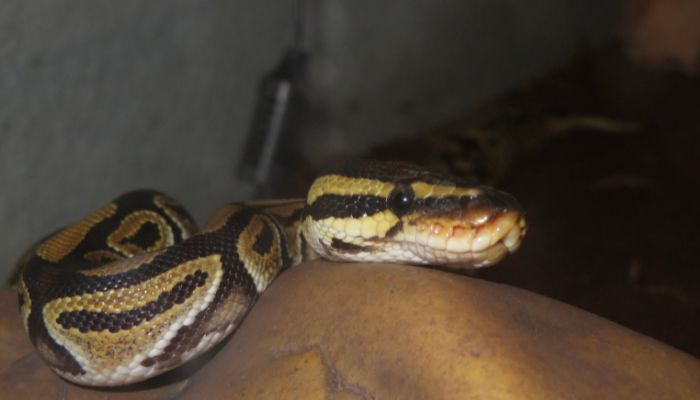
The Importance of Heat for Ball Pythons
Ah, the world of Ball Pythons! These slithering beauties have captured the hearts of many reptile enthusiasts. But, like any pet, they come with their unique set of needs.
One of the most debated topics among Ball Python owners is the nighttime heating conundrum. So, let’s dive deep and unravel the mystery: Do Ball Pythons really need a heat lamp at night?
The role of heat in the digestion process.
Imagine you’ve just had a hearty meal. You’re feeling full, content, and all you want to do is lounge on your couch, maybe even take a nap. Now, think of Ball Pythons.
After they’ve had their meal, they too need some ‘couch time’, but in their world, it’s basking time. Heat plays a pivotal role in their digestion process.
Without the right amount of warmth, the food can rot inside them, leading to regurgitation or worse, severe health issues.
It’s like trying to cook a meal without turning on the stove. The heat aids in breaking down the food, ensuring that all those essential nutrients are absorbed efficiently.
The dangers of using heat rocks.
Now, while we’re on the topic of heat, let’s address a common misconception: heat rocks. They might sound like a great idea, right?
A rock that emits heat, mimicking the natural environment. But here’s the catch: heat rocks are notorious for causing burns. Unlike heat lamps or under-tank heaters, which distribute heat evenly, heat rocks can have hotspots.
These uneven temperatures can be extremely harmful. Imagine sitting on a heated seat with random areas that feel like they’re on fire. Not the best experience, right? That’s what a Ball Python might feel on a heat rock.
How heat aids in their overall health and well-being.
Beyond digestion, heat is crucial for a Ball Python’s overall health and well-being. These creatures are ectothermic, meaning they can’t regulate their body temperature internally like we do. They rely on their environment.
The right amount of heat ensures they remain active, hydrated, and free from illnesses. It’s akin to us humans getting our daily dose of Vitamin D from the sun.
Without it, we’d feel lethargic, and our immune systems would take a hit. Similarly, for Ball Pythons, heat is not just about comfort; it’s a necessity for survival.

Optimal Temperatures for Ball Pythons
Alright, let’s get into the nitty-gritty of Ball Python care. If you’ve ever wondered why temperature is such a big deal for these creatures, you’re about to find out. Let’s embark on this thermal journey together!
The cold-blooded nature of Ball Pythons.
First off, let’s clear up a common misconception. When we say Ball Pythons are “cold-blooded”, it doesn’t mean they have ice running through their veins. It means they’re ectothermic. In simpler terms, they can’t generate their own body heat.
Think of them as living thermometers, adapting to the temperature of their surroundings. While we humans can throw on a sweater or crank up the AC, Ball Pythons rely entirely on their environment to feel just right.
Importance of external heat sources for their metabolism and health.
Now, because of their ectothermic nature, external heat sources aren’t just a luxury for Ball Pythons; they’re a necessity. Heat plays a pivotal role in everything from their digestion to their overall activity levels.
Without proper heat, their metabolic processes slow down, making them lethargic and affecting their appetite. It’s like trying to run a car without fuel; it just won’t work.
Ideal ambient temperature and basking spot temperature during the day.
Alright, let’s talk numbers. During the day, the ambient temperature in a Ball Python’s enclosure should hover between 82–88 degrees Fahrenheit (28–31°C). But wait, there’s more! They also need a basking spot, a warmer area where they can soak up some extra heat.
This basking spot should be slightly hotter, around 90–95 degrees Fahrenheit (32–35°C). Think of it as their personal sunbathing spot, where they can lounge and soak up the warmth.
Nighttime temperature requirements.
When the sun goes down, it’s natural for temperatures to drop a bit. The same goes for your Ball Python’s enclosure. At night, aim for an ambient temperature of 75–80 degrees Fahrenheit (24–27°C).
While it’s cooler than daytime temperatures, it’s essential to ensure it doesn’t drop too low, as that can stress out your snake.
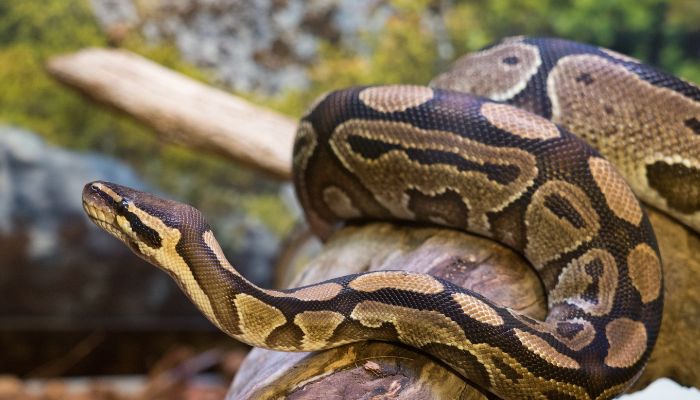
Importance of monitoring temperature with a thermometer.
Now, you might think you’re all set with setting up the heat sources. But there’s one more crucial tool you need: a reliable thermometer. Monitoring the temperature ensures that your Ball Python’s environment remains consistent.
Fluctuations can stress them out and lead to health issues. So, invest in a good-quality thermometer, and consider placing multiple ones in different parts of the enclosure to get an accurate reading.
Heat Lamps vs. Other Heating Methods
When it comes to keeping our slithery friends warm, there’s more than one way to light the fire. Heat lamps are the popular kids on the block, but there are other contenders in the ring. Let’s break down the battle of the heating methods!
Compare heat lamps to other heating methods like heat mats.
Heat lamps are like the sun of the reptile world. They radiate warmth from above, mimicking the natural warmth Ball Pythons would get basking under the sun. On the flip side, heat mats act like the warm earth beneath, providing belly heat.
While heat lamps focus on creating a basking spot, heat mats ensure the entire floor of the enclosure is toasty.
The pros and cons of each method.
Heat Lamps: Pros:
- Provides a focused basking spot.
- Can aid in maintaining ambient temperature.
- Visible light can help simulate a day-night cycle.
Cons:
- Risk of burns if not properly installed.
- Can dry out the enclosure if not monitored.
- Bulbs may need frequent replacement.
Heat Mats: Pros:
- Provides consistent belly heat.
- Low risk of burns when used with a thermostat.
- Energy efficient and long-lasting.
Cons:
- Doesn’t offer a focused basking spot.
- May not be sufficient as the sole heat source in colder climates.
The importance of monitoring and regulating temperatures.
No matter the method, monitoring is key. Think of it as the guardian angel of your Ball Python’s world. Without regular checks, temperatures can fluctuate, leading to a stressed and unhealthy snake.
Using thermostats and thermometers ensures the heat remains consistent, offering peace of mind to both you and your python.

Nighttime Needs: Do Ball Pythons Require Continuous Heat?
Ah, nighttime, when the world quiets down. But what about our Ball Pythons? Do they snuggle up in a warm blanket of continuous heat, or do they prefer a slight chill?
The debate on whether ball pythons need heat at night.
The great debate! Some argue that since Ball Pythons experience cooler nights in the wild, a drop in temperature is natural. Others believe that a consistent temperature is key to their well-being.
The truth?
A slight drop is beneficial, but it shouldn’t be drastic.
The benefits of a nighttime temperature drop.
A nighttime drop can simulate a Ball Python’s natural environment, promoting regular behaviors and better sleep cycles. It can also aid in digestion and metabolism, ensuring they process their meals efficiently.
The importance of maintaining a temperature gradient in the enclosure.
Regardless of day or night, a temperature gradient is crucial. This gradient allows Ball Pythons to thermoregulate, moving between warmer and cooler spots as needed. It’s like us moving between the shade and sunlight on a warm day.
By maintaining this gradient, you ensure your Ball Python has the freedom to choose its comfort zone, leading to a happier, healthier pet.
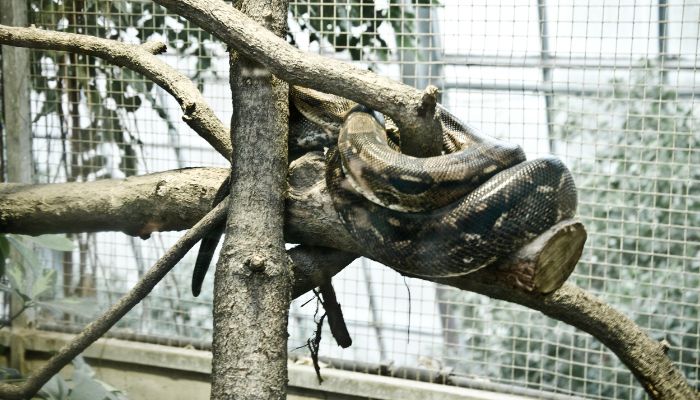
Choosing the Right Heat Lamp
Alright, so you’ve decided to go the heat lamp route for your Ball Python. Great choice! But wait, before you rush to the store or click that ‘buy now’ button online, let’s ensure you pick the right one.
After all, not all heat lamps are created equal.
Tips for selecting the best heat lamp for ball pythons.
Selecting the right heat lamp is like choosing the perfect pair of shoes. It needs to fit just right. Here’s what you need to consider:
- Size of the Enclosure: A larger enclosure might require a higher wattage lamp, while a smaller one might do just fine with a lower wattage.
- Purpose: Are you looking for a primary heat source or just a supplemental one? This will influence your choice.
- Durability: Look for brands known for longevity. You don’t want to be replacing bulbs every other month.
Wattage, type of bulb, and safety precautions.
Wattage: This is the power of the bulb. Typically, for Ball Pythons, bulbs ranging from 50 to 100 watts are used. However, always refer to the manufacturer’s guidelines and consider the size of your enclosure.
Type of Bulb: There are various types, like infrared, ceramic, and basking bulbs. For nighttime, ceramic bulbs are great as they emit heat without light, ensuring your python gets its beauty sleep.
Safety Precautions:
- Always use a lamp holder or clamp to secure the lamp in place.
- Ensure the lamp is not in direct contact with any surface inside the enclosure.
- Use a mesh screen or guard to prevent your python from getting too close and risking burns.
The significance of using thermostats to regulate temperature.
Now, imagine driving a car without brakes. Scary, right? Using a heat lamp without a thermostat is somewhat similar. A thermostat acts as a regulator, ensuring the temperature doesn’t skyrocket or plummet.
It maintains a steady, comfortable environment for your Ball Python. By automatically turning the heat lamp on or off based on the set temperature, it prevents overheating and ensures your snake’s enclosure remains a cozy haven.
Remember, choosing the right heat lamp is a blend of science and art. It’s about understanding the needs of your Ball Python and ensuring its comfort and safety.
So, take your time, do your research, and make an informed choice. Your slithery friend will surely thank you for it!
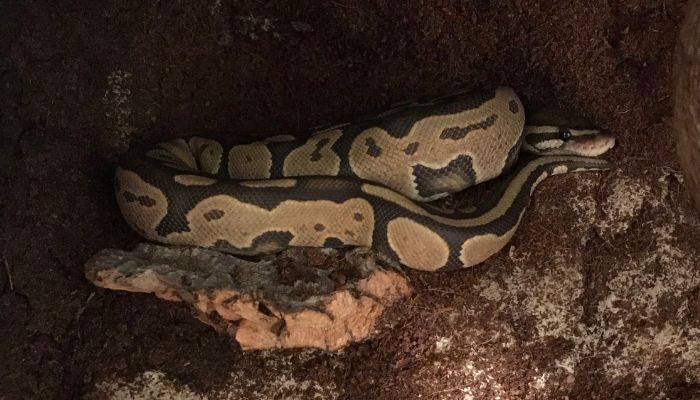
Potential Risks and How to Avoid Them
Navigating the world of Ball Python care can sometimes feel like walking a tightrope. While providing warmth is essential, there’s a thin line between comfort and danger.
Let’s delve into the potential risks and, more importantly, how to sidestep them.
The dangers of overheating and how it can harm ball pythons.
Overheating is like the silent villain in the Ball Python world. It sneaks up, often unnoticed until it’s too late. When a Ball Python’s enclosure gets too hot, it can lead to dehydration, stress, and in severe cases, fatal burns.
Just as we’d feel uncomfortable and potentially fall ill in an overly heated room, Ball Pythons too can suffer from heat-related ailments.
Their ectothermic nature means they rely on external temperatures to function, and any extreme can throw their systems off balance.
Solutions and tips to ensure the safety of the snake.
1. Use a Thermostat: This device is your first line of defense against overheating. It regulates the temperature, ensuring it remains consistent.
2. Multiple Thermometers: Place thermometers at different spots in the enclosure. This way, you can monitor the temperature gradient and ensure no area is getting too hot.
3. Mesh Guards: These act as barriers between the heat lamp and the snake, preventing direct contact and potential burns.
4. Regularly Check Equipment: Ensure all heating equipment is in good working condition. A malfunctioning heat mat or lamp can quickly lead to overheating.
5. Provide Shade: Ensure there are cooler spots or hides in the enclosure where the snake can retreat if it feels too warm.
The importance of regular monitoring and adjustments.
Regular monitoring isn’t just a good-to-do; it’s a must-do. Think of it as a routine health check-up for your Ball Python’s environment.
By keeping a close eye on temperatures and making adjustments as needed, you’re not just ensuring comfort; you’re ensuring longevity and health.
Remember, consistency is key. Regular checks and tweaks can make all the difference between a thriving Ball Python and one that’s merely surviving.
While heating is essential, it comes with its set of challenges. But with the right knowledge, tools, and a dash of diligence, you can create a warm, safe, and cozy haven for your Ball Python. After all, a happy snake makes for a happy snake parent!

Final Word
In your journey to provide the best care for your Ball Python, understanding their heating needs is paramount. As we’ve explored, these captivating creatures rely heavily on external heat sources for their well-being.
From the importance of maintaining optimal temperatures to the debate surrounding nighttime heating, it’s clear that a well-regulated environment is key to a thriving Ball Python.
While heat lamps are a popular choice, it’s essential to weigh their benefits against other heating methods, always prioritizing the safety and comfort of your slithery friend.
Remember, every Ball Python is unique, and observing their behavior is crucial. Adjustments might be needed along the way, but with the knowledge you’ve gained from this article, you’re well-equipped to make informed decisions.
Caring for a Ball Python is a rewarding experience, and your dedication to understanding their needs will undoubtedly lead to a long, healthy life for your pet.
Keep up the great work, and here’s to many warm and cozy moments with your Ball Python!
FAQ
Navigating the world of Ball Python care can be filled with questions. Let’s tackle some of the most frequently asked ones to shed light (pun intended!) on the subject.
Can I turn off my ball python’s heat lamp at night?
Yes, you can. However, it’s essential to ensure the enclosure maintains an adequate temperature. Many owners use under-tank heaters or heat mats at night to provide consistent warmth without light.
Are night lights good for ball pythons?
Ball Pythons, being nocturnal, are used to darkness at night. While night lights, especially dim ones, won’t necessarily harm them, it’s best to give them a natural night-time environment. If you’re using it for observation, ensure it’s not too bright or disruptive.
Can you leave a red heat lamp on all night for a ball python?
Red heat lamps emit minimal light, making them a popular choice for nighttime heating. They can be left on all night, but it’s crucial to monitor the temperature and ensure it doesn’t get too warm. Using a thermostat can help regulate the heat effectively.

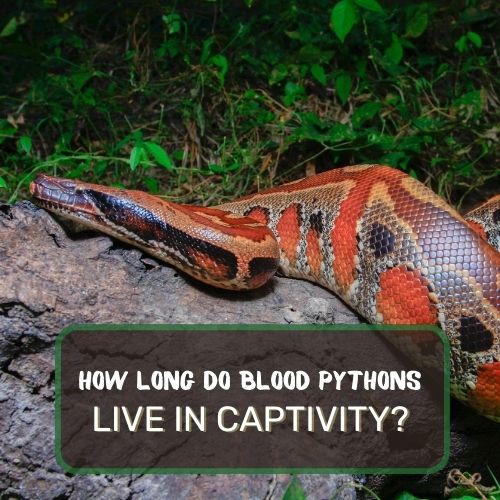


0 Comments